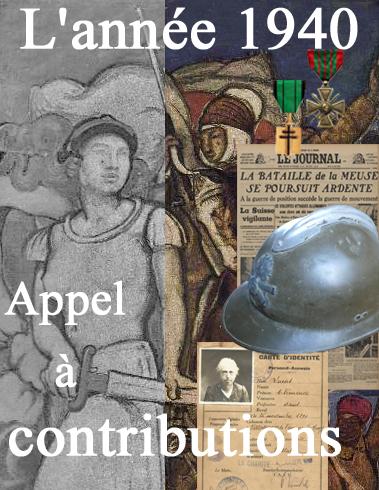Call for contributions for the 80th anniversary of 1940
Remember the date in your own way, in images, words or drawings

For France, 1940 was a drama in three acts, opening with the “Phoney War”, followed by the collapse of the “Strange Defeat” and ending with the first glimmers of what was to be a political and military revival.
1940 was Sedan and the rout, exodus and occupation, but it was also Narvik, the heroism of the cadets of Saumur, a time of desperate fighting and last-ditch counter-attacks.
1940 was Marshal Pétain, the armistice and taking the path of collaboration, but it was also General de Gaulle, the call to arms of 18 June and the first demonstrations of resistance. It was the birth of Free France, both in metropolitan France and in the territories of the Empire, and also the creation of the Order of Liberation, to honour the pioneers of the Resistance and the outstanding feats carried out for the liberation of the country.
Eighty years on, the Ministry of the Armed Forces invites you to commemorate the 80th anniversary of 1940 by making a whole series of scientific and educational resources available to you, on a dedicated web page.
Meanwhile, the Ministry is also teaming up with the Ministry of National Education and Youth to launch a call for contributions.
For high-school students, getting involved will mean the chance to find out more about 1940, which forms an essential part of the new final-year lycée syllabuses. For both high-school and middle-school students, it will also be an opportunity to expand upon the chosen theme of this year’s Concours National de la Résistance et de la Déportation schools competition: “1940: Joining the Resistance – Understanding, refusing, resisting”.
For the younger ones, first-hand accounts of those who were children at the time serve as a starting point for a discussion at home about what the war might have represented for your great-grandparents, in some cases including the experience of the exodus.
Because this commemoration is also yours, because this history is our history, we invite you to journey down the paths of remembrance of 1940, with texts, archive photographs, objects and drawings on this theme.
The older ones among you, or their descendants, might like to explore their family archives and send us digitised versions of their personal documents, with a few lines of introduction.
For those who prefer the spoken to the written word, you have the option of making a short video about your personal relationship with this period, answering questions like “Where were your parents/grandparents in 1940?”, “What does this commemorative year mean to you?”, “Have you ever taken part in a local or national ceremony of an event from 1940?”, or anything else you can think of.
Last of all, younger children are invited to send in a drawing or other artwork telling what this period or a particular episode in it means to them.
Parce que cette commémoration est aussi la vôtre, parce que cette histoire est notre histoire, nous vous invitons à emprunter vous-mêmes les chemins de la mémoire de l’année 40 en proposant des textes, des images d’archives, des objets et des dessins autour de ce thème.
Your contributions should be sent by 1 December 2020 to:
dpma-ceremonies.contact.fct@intradef.gouv.fr
They will be published on the website www.cheminsdememoire.gouv.fr and on the social media pages of the Ministry of the Armed Forces.
A brief history of 1940
On 3 September 1939, Great Britain, followed by France, declared war on Germany, following the German invasion of Poland. Apart from a small number of “coup de main” attacks and peripheral operations, the front remained inactive until 10 May 1940, when the Germans went ahead with a brutal offensive.
After the “Phoney War”, violent fighting ensued. In six weeks, despite the occasional tactical victory and the successes achieved on the Alpine front, the French armies were swept aside and the Battle of France ended with what French historian Marc Bloch described as the “Strange Defeat”. An exodus ensued, as millions of civilians fled the advancing invaders. On 17 June 1940, Marshal Pétain, the new head of the French government which had taken refuge in Bordeaux, requested an armistice. Signed at Rethondes on 22 June, the armistice imposed particularly harsh terms on France. Together with the armistice signed with Italy on 24 June, it established the long-term partition of the country on either side of a demarcation line, the southern side of which, soon to be placed under the authority of the new Vichy regime, entertained the illusion of French sovereignty. Yet by October 1940, Marshal Pétain had officially chosen the path of collaboration with Nazi Germany.
However, on 18 June 1940, General de Gaulle issued a call to arms from London, which marked the birth of the French Resistance. In the initial weeks, he was joined by hundreds of Frenchmen and women, who would form the core of the Free French Forces. In August 1940, the rallying of part of the African territories gave Free France a territorial base and the manpower with which to resume the fight alongside the Allies. Finally, in November 1940, a demonstration by high-school and university students on the Champs Élysées bore witness to this same refusal of defeat and foreign occupation. And so it was that, in 1940, “from the bottom of the abyss, [France] got to her feet and climbed the slope” (Charles de Gaulle, Mémoires de guerre – L’appel : 1940-1942).
Visit our page dedicated to the 80th anniversary of 1940
View the digital offering of the DPMA’s partner museums and remembrance sites

